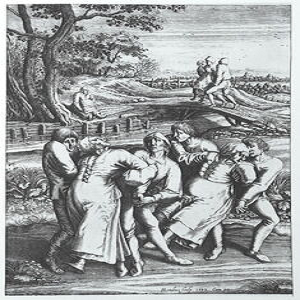Doctor Curmudgeon Gotta Dance!
By Diane Batshaw Eisman, M.D. FAAP Doctor Eisman is in Family Practice in Aventura, Florida with her partner, Dr. Eugene Eisman, an internist/cardiologist
Gotta dance?
Who is it that absolutely has to dance?
Sammy Davis, Junior and his tap shoes?
Mikhail Baryshnikov and his ballet shoes?
Fred Astaire and Ginger Rogers?
Gene Kelly and his umbrella?
This column is not about any of these great dancers; it is about a mysterious piece of Medieval history—those poor souls who were caught up in a dancing epidemic in 1518—people who uncontrollably danced for weeks.
This dancing mania occurred in Strasbourg, Alsace, France. The frenzy lasted from July 1518 to September of that year—and came to be known as the Dancing Plague of 1518.
Frau Troffea was a resident of Strasbourg. One day in July 1518, she stepped into the narrow street in front of her home. With an impassive face, Frau Troffea began uncontrollably twisting turning, and dancing.
None of the witnesses heard any music. She simply began to dance with great fervor. About 40 other people joined her in that cobble stoned street.
“History Tools” comments that this dancing frenzy was not limited to France; it spread along the Rhine with about 500 people being afflicted…
No sources are available relating to specific deaths but bodies began to pile up in the streets. There was an incredible stench. Pits were dug—and the dead were thrown in.
Writing in the 1620s, the German-Swiss physician Paracelsus postulated that ergot was the cause of the dancing plague. (Ergot – is a fungal infection of rye that can produce psychotropic symptoms.).
But modern historians have doubts about the ergot theory. Ergot poisoning is more likely to cause gastrointestinal symptoms, convulsions, delusions and hallucinations.
Historian John Waller writes in his book, “A Time to Dance, a Time to Die: The extraordinary Story of the Dancing Plague of 1518’: “The people of Strasbourg and its environs were, by 1518, mentally and physically exhausted by disease, crop failures, and constant warfare.”
Waller comments that the people of the city were desperately poor and malnourished. This was an atmosphere that created psychological disturbance among the populace—it didn’t take much for a woman dancing in the street to be the trigger of a dancing epidemic.
Waller notes that some religious people in the 16th century believed that a Catholic Saint, St. Vitus, had the power to place a curse on sinful people with a dancing plague. By dancing, they would free themselves of sins. Writing about the Ergot theory in “The Lancet,” Waller says that it cannot explain that almost all outbreaks occurred “along the Rhine and Moselle rivers, areas linked by water but with quite different climate and crops.”
But none of these theories really explain what happened. At this time, Waller’s theory of “stress-induced psychosis on a mass level” is plausible.
The Dancing Plague of 1518 brings to mind a story written by Hans Christian Andersen. He tells of a girl whose red shoes will not allow her to stop dancing. Was the dancing plague of 1518 in his mind as he wrote?
THE PHOTO IS AN ENGRAVING BY HENDRIK HONDIUS SHOWING PEOPLE AFFECTED. IT IS BASED ON AN ORIGINAL DRAWING BY PIETER BRUEGHEL.
NOTE: I WAS UNABLE TO FIND SPECIFIC SUPPORTING DOCUMENTS. To satisfy my readers, my editor, Galahad, the Siberian Husky who is my cousin found Stephanie Landsem writing in “Historic Epidemics: the Dancing Plague of 1518:” Historical documents of the time all agree that in July of that year, in the streets of Strasburg, Alsace… a single woman began to dance in a frenzied way. More people…joined in.”
Dr. Curmudgeon suggests “Bitter Medicine”, Dr. Eugene Eisman’s story of his experiences–from the humorous to the intense—as a young army doctor serving in the Vietnam War.
Bitter Medicine by Eugene H. Eisman, M.D. –on Amazon
Doctor Curmudgeon® is Diane Batshaw Eisman, M.D., a physician-satirist. This column originally appeared on SERMO, the leading global social network for doctors.
SERMO www.sermo.com
Click Here to Order Boxing Interviews Of A Lifetime By “Bad” Brad Berkwitt


